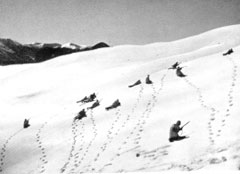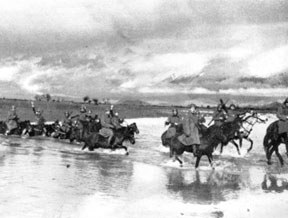Ellinikos
Stratos
By Mike Bennighof, Ph.D.
December 2013
Hence we will not say that Greeks fight like heroes, but that heroes fight like Greeks.
- Winston Churchill
The modern Greek state emerged in 1832, eleven years after a handful of Greek patriots had declared their independence from Ottoman Turkey. For the next century, Greek politicians kept alive the idea of liberating their "unredeemed" brethren still under Ottoman rule. Often tied to this was the notion of a reborn Byzantine Empire, with its capital at Constantinople and including all the former Greek lands around the Aegean and Black Seas and in Anatolia.
The result was a series of wars with the Ottomans, culminating in a savage war fought between 1919 and 1922 that ended with Greek defeat. Ethnic cleansing and genocide had been carried out on a massive scale, and at least one million Greeks expelled from Turkish territory had to be absorbed. Among the casualties was the Greek monarchy, and between 1924 and 1935 Greece suffered repeated coups d'etat. Finally the monarchy was restored following a vote rigged by the army in heavy-handed fashion.
Returning to the throne in 1936, King George II established a royal fascist regime, serving as figurehead for the dictator Ioannis Metaxas. Metaxas forged close economic ties to Germany, while the king favored Britain. In the fall of 1940 the Italian government demanded the right to occupy un-named points in Greek territory, and Metaxas supposedly retorted with the single word "Ochi," or "No."
When Metaxas rejected
Italy’s rather vague demands for submission
in late October 1940, he did so from a very
weak military position, at least on paper.
The worldwide economic depression of the 1930s
had hit Greece especially hard, and the armed
forces disposed of very little modern equipment.

Greek gunners and a 65mm mountain gun,
1940. |
Italian forces invaded Greece from Italian-occupied
Albania on 28 October 1940, but were hampered
by poor logistical planning and worse leadership.
The Greek Army had to divide its forces between
the Albanian front and the border facing Bulgaria,
long known to be very hostile to Greece. The
“Army of Western Macedonia” holding
the eastern half of the frontier had one division
and one brigade, plus a number of independent
mountain infantry units, the famous skirt-wearing
“Evzones.” The Epirus Detachment
covering the western part of the line also
had just one division and one brigade. Against
them the Italian sent only one armored, one
mountain and four infantry divisions, somewhat
better equipped but smaller than the Greek
units (Italian “divisions” were
about the size of other armies’ brigades).
Unable to score a quick victory, though
Italian Alpini made a gallant advance deep
into the Greek lines, the Italians had given
the Greeks time for mobilization. By early
November Greek forces on the Albanian frontier
were up to seven divisions and two brigades;
after the Greeks determined that Bulgaria
would not join the attack their forces there
rose to 12 infantry divisions, four brigades
plus a cavalry division.

Evzones mobilize for war, September 1940.
|
At maximum strength, the Ellinikos Stratos,
or Royal Hellenic Army, numbered 19 infantry
divisions, one cavalry division, one motorized
division and one tank brigade. Even that strength
is deceiving: several of the divisions were
no more than re-designated infantry brigades.
Artillery was weak even by the standards of
1914, with most divisions having only 32 guns
on paper, 24 of them 75mm pieces, and fewer
than that in reality. The infantry brigades
often had no artillery at all beyond a handful
of Italian-made 65mm mountain guns suitable
for nothing more than direct-fire support.
The “motorized” division moved
its infantry in requisitioned buses and its
artillery and supplies with captured Italian
trucks. The tank “brigade” had
but six Italian
Fiat 3000B machines and four Vickers Type
E (very similar to the Soviet T-26); 40 Carden-Lloyd
light tanks ordered by the Dutch but cancelled
due to their utter uselessness had been picked
up by the Greeks but not delivered before
Greece fell to German attack in April 1941.

Greek infantry in the Pindos Mountains,
1940. |
Greece had paid some attention to anti-aircraft
defense and possessed a better range of anti-aircraft
weapons than most of Eastern Europe’s
bayonet armies, including several dozen of
the fearsome Rheinmetall-Borsig 88mm anti-aircraft
gun. But financial hardship made ammunition
short, and the German Afrika Korps had not
yet taught the world what those guns could
do to tanks.
 Greek cavalrymen advance into Albania,
December 1940.
Greek cavalrymen advance into Albania,
December 1940. |
In Third Reich we represented those forces with three 2-3 infantry units and one 1-3 INF, plus one TAC factor and two SURF. One more 1-3 INF is in the Force Pool and can be constructed once Greece is at war.
Greece expanded her land forces as she mobilized, equipping them with captured Italian weapons as Greece's allies proved unable or unwilling to send much in the way of material aid. Greece also deployed six submarines during the war, which performed gallantly both during the Italian invasion and afterwards from exile.
In all scenarios, in the Production Segment of the second turn after the turn when Greece first goes to war with any Major Power, replace any Greek 2-3 INF with a Greek 3-3 INF (controlling player’s choice; can be an on-board unit or one in the force pool). So for example, if Greece first goes to war with any Major Power in Fall 1940, make the replacement in the Spring 1941 Production Segment. Remove the replaced 2-3 INF from play permanently. Of course, none of this happens if Greece has surrendered by then.
In all scenarios that begin in 1939 or later, add 1 SUB to Greece’s At-Start Units and 2 x 1-3 INF to Greece’s force pool. In the 1938 scenario, add 1 SUB and 2 x 1-3 INF to Greece’s force pool in the Spring 1939 Production Segment.
You can download the new pieces here.
Order Third Reich right here! |


